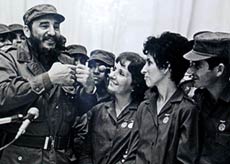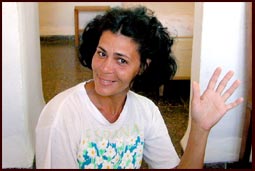|
Havana
| Havana
is home to 2.2 million people, and while it is possible to explore
the city by bike, there are obvious hazards in urban riding. Today
there are many more cars, trucks, and buses zooming around Havana
than there were in the depths of the Special Period. Nevertheless,
we spent more time in the city than on our
year-2000 tour, and for the most part we enjoyed it. |
|
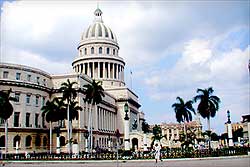 |
|
 |
|
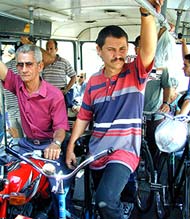 |
|
On the
assumption that many cycle tourists will arrive in Cuba via Havana,
Bicycling Cuba, will give details on the safest, easiest
ways to get out of the city by bike. One of these escape routes
uses the cyclobus, an old city bus that has been gutted to carry passengers
with their bicycles and small motorcycles through the harbor tunnel
|
|
 |
|
| Still,
while you are in Havana, there is much worth seeing and doing —
whether you choose to explore by bike, on foot, or by using the variety
of transportation now available. |
|
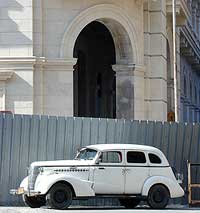 |
|
 |
|
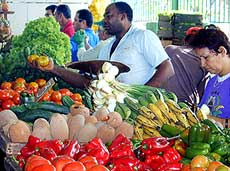 |
|
Even
if you are in the city for only a short while, it is worthwhile to
visit one of Havana's many agromercados — farmers' markets
— now well stocked with fruit and vegetables that sell for pesos. |
|
 |
|
| Our favorite
route to the south and west leads past the Plaza de La Revolución,
the centerpiece of which is the imposing monument and museum honoring
José Martí. |
|
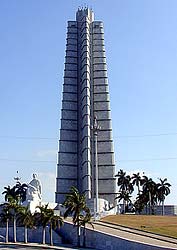 |
|
 |
|
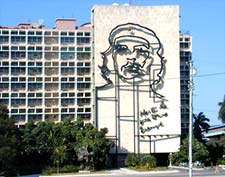 |
|
Facing
the Plaza de la Revolucion, the office building of the Ministry of
the Interior bears this famous portrait of Che Guevara. |
|
 |
|
| Another
escape route begins on the Malecon, Havana's famous oceanfront boulevard.
The Malecon passes several important monuments. |
|
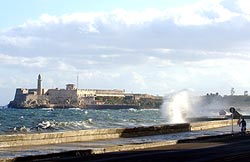 |
|
 |
|
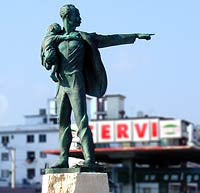 |
|
One of
our favorite sites along the Malecon is Plaza Martí. This simple,
concrete plaza is perhaps a couple of hundred meters long. At one
end stands a statue of José Martí, Cuba's national hero,
carrying a child in his arms. This plaza goes unmentioned in all the
tourist literature we have seen, but we will explain why it seems
important to us. |
|
 |
|
| Plaza
Martí is directly in front of the U.S. Interests Section. Beside the
plaza, facing the Interests Section, is the famous billboard depicting
a defiant Cuban saying to Uncle Sam, "Mr. Imperialist, we are
not one bit afraid of you." |
|
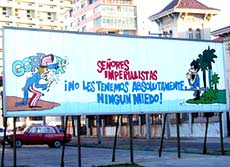 |
|
 |
|
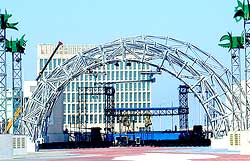 |
|
Also
directly in front of the US Interests Section, a stage has been
erected. Steel towers and arches looming above the plaza support
lights and loudspeakers. Here, protests are frequently held. In
fact, Cubans jokingly call this place the Protestadio, the Stadium
for Protests. (It was an exceedingly busy place during the Elian
Gonzales affair in 2000.) If there is any place in the world
that is the focus of symbolic, hostile confrontation between Cuba
and the US, this is it.
|
|
 |
|
|
In the
photo above, you can just see arrays of brass plaques on the concrete
bases of two of the steel towers — one on the lower right,
the other on the lower left. The plaques on the right bear the names
of heroes to Cubans: Marx, Engels, Lenin, Che Guevara, and dozens
of leaders and martyrs of Cuba's struggles for independence.
|
|
|
|
 |
|
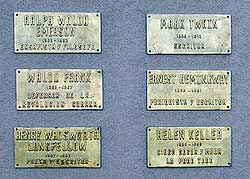 |
|
On the
base of the tower on the left, similar plaques honor North Americans!
In this photo are the plaques for Ralph Waldo Emerson, Mark Twain,
Waldo Frank, Ernest Hemingway, Henry Wadsworth Longfellow, and Helen
Keller. Others who are honored include Jane Addams, Nat Turner, Abraham
Lincoln, Martín Luther King, Thomas Edison, Linus Pauling, Frank Lloyd
Wright, Frederick Douglas, Clara Barton, Dr. Benjamin Spock, Malcolm
X, and many more. |
|
 |
|
Barbara and
I find it strangely moving to see that Cubans, whom US law treats as enemies,
admire so many of the same historic figures that Americans themselves
do. Nothing demonstrates better the values that Cuba and the U.S. share,
the intimate, historical ties between these two estranged nations.
|
Far
from being treated as enemies, Americans are warmly welcomed by
the Cuban people. This photo was a memento belonging to a family
with whom we stayed in Havana. The woman closest to Fidel was our
host. She had risen to the rank of Colonel in the Cuban Army. Her
husband had been in an underground cell at the start of the revolution,
and he is recently retired from a position at the university. Both
are strong supporters of Fidel and the revolution, and we imagine
they are what some Americans would describe as members of Cuba's
"communist elite."
|
|
|
|
 |
|
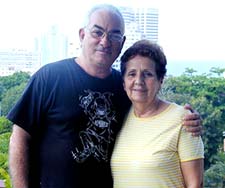 |
|
Yet here
are Raul and Magaly today, grandparents just like us, with the same
aspirations for their children and grandchildren. Despite the deep
differences in the U.S. and Cuban political and economic systems and
their commitment to the revolution, they do not understand why we
must be enemies — nor do we. (Raul maintains a web site, www.geocities.com/vedadohabana,
to promote their casa particular and to welcome and inform
foreign visitors. The "Travel Tips" link on his page leads
to a great deal of useful information.) |
|
 |
|
|












